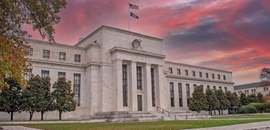While investors could also place money in bank savings accounts, their deposit rates are considerably below MMF rates. For example, the average rate on savings accounts nationwide, according to Lending Tree, is only 0.37%, although there is a wide variation among individual banks.
Until recently, banks were slow to increase rates as the Fed tightened monetary policy because they thought deposits were sticky. According to a report by the Federal Reserve Bank of New York, the response of retail three-month CD rates to changes in the effective federal funds rate (called the deposit beta) has been much lower than that for money market funds (see chart below). For example, during the period from the beginning of 2022 through March of 2023, the pass through of a one percentage point increase in the funds rate was 0.26 percentage points for bank CDs versus 0.86 percentage points for retail MMF accounts.
Figure 1.The MMF Beta is Higher than the Deposit Beta

Chart source: FRBNY; Data source: Federal Reserve Bank of St. Louis FRED database; RateWatch; iMoneyNet.
Note: The chart plots the EFFR, the net yield on MMF shares, and the rate on three-month CDs from January 2002 to January 30, 2023.
As Bank Withdrawals Increase, Money Market Funds Balloon
More recently, a growing number of banks and asset managers have responded by offering more attractive rates on CDs, with some CDs now topping 5%. These instruments are similar to savings accounts in that they carry protection up to $250,000 per individual. However, the holder cannot touch the instrument for a designated period—whether for a few months or up to five years or more. In this respect, they are less liquid than money market instruments.
Are Money Market Funds the Right Spot for Your Cash?
One consideration for investors in money market funds is they do not come with FDIC deposit insurance. However, they are bound by a strict set of rules, known as SEC Rule 2a-7, that carry restrictions on diversification, credit quality, liquidity, and the maturities of the instruments they can hold to maintain the stability and safety of principal. Roughly 40% of their holdings are parked in reverse repos with the Federal Reserve, and the weighted average maturity for the 100 largest MMF has declined to just 15 days from an average of 35 days over the past decade according to Crane Data. This means they do not have significant credit risk or duration risk.
Another consideration is that by holding short-dated instruments investors are subject to reinvestment risk on them. That is, they could miss out on a rally in bonds or stocks if the Fed were to lower interest rates. In a previous commentary, I noted that this outcome is being priced into the bond market, where investors anticipate that the funds rate at the end of this year will be about 75 basis points below the level in the FOMC projections.
My take is that while the Fed may pause in raising rates now, it will be very reluctant to lower them as long as inflation is well above the Fed’s 2% average annual target. Although prices of goods have declined as supply-chain bottlenecks have eased, wages and prices for many service items have stayed elevated. Consequently, officials are wary about losing the Fed’s credibility as an inflation fighter after they were burned on their call that inflation would be temporary.
Beyond this, Fed officials must also recognize that by keeping interest rates artificially low, they have contributed to bubbles in financial markets and real estate in the past two decades. Throughout this period, the mantra of many investor has been TINA – meaning “there is no alternative” to holding equities or other long duration assets.
Now, for the first time in a long while, investors are being adequately compensated for holding more predictable and less-risky assets. This is especially important for retirees and low-income earners who cannot bear the risk of market fluctuations.
Investment Environment is Challenging—And May Remain So
In these circumstances, it is understandable that many investors are uncertain about what to do with spare cash. Fortunately, they can finally earn a reasonable return on their cash holdings now.
A version of this article was posted to Forbes.com on May 8, 2023.
This publication has been distributed for informational purposes only and should not be considered as investment advice or a recommendation of any particular security, strategy, or investment product. Opinions expressed in this commentary reflect subjective judgments of the author based on the current market conditions at the time of writing and are subject to change without notice. Information and statistics contained herein have been obtained from sources believed to reliable but are not guaranteed to be accurate or complete. Past performance is not indicative of future results. No part of this publication may be reproduced in any form, or referred to in any other publication, without express written permission of Fort Washington Investment Advisors, Inc.


























